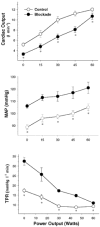Combined inhibition of nitric oxide and prostaglandins reduces human skeletal muscle blood flow during exercise
- PMID: 12205200
- PMCID: PMC2290499
- DOI: 10.1113/jphysiol.2002.021477
Combined inhibition of nitric oxide and prostaglandins reduces human skeletal muscle blood flow during exercise
Abstract
The vascular endothelium is an important mediator of tissue vasodilatation, yet the role of the specific substances, nitric oxide (NO) and prostaglandins (PG), in mediating the large increases in muscle perfusion during exercise in humans is unclear. Quadriceps microvascular blood flow was quantified by near infrared spectroscopy and indocyanine green in six healthy humans during dynamic knee extension exercise with and without combined pharmacological inhibition of NO synthase (NOS) and PG by L-NAME and indomethacin, respectively. Microdialysis was applied to determine interstitial release of PG. Compared to control, combined blockade resulted in a 5- to 10-fold lower muscle interstitial PG level. During control incremental knee extension exercise, mean blood flow in the quadriceps muscles rose from 10 +/- 0.8 ml (100 ml tissue)(-1) min(-1) at rest to 124 +/- 19, 245 +/- 24, 329 +/- 24 and 312 +/- 25 ml (100 ml tissue)(-1) min(-1) at 15, 30, 45 and 60 W, respectively. During inhibition of NOS and PG, blood flow was reduced to 8 +/- 0.5 ml (100 ml tissue)(-1) min(-1) at rest, and 100 +/- 13, 163 +/- 21, 217 +/- 23 and 256 +/- 28 ml (100 ml tissue)(-1) min(-1) at 15, 30, 45 and 60 W, respectively (P < 0.05 vs. control). In conclusion, combined inhibition of NOS and PG reduced muscle blood flow during dynamic exercise in humans. These findings demonstrate an important synergistic role of NO and PG for skeletal muscle vasodilatation and hyperaemia during muscular contraction.
Figures




References
-
- Bauersachs J, Popp R, Hecker M, Sauer E, Fleming I, Busse R. Nitric oxide attenuates the release of endothelium-derived hyperpolarizing factor. Circulation. 1996;94:3341–3347. - PubMed
-
- Boushel R, Langberg H, Olesen J, Nowak M, Bulow J, Kjær M. Regional blood flow in muscle and peritendinous tissue during exercise measured by near infrared spectroscopy and indocyanine green. Journal of Applied Physiology. 2000;89:1868–1878. - PubMed
-
- Cowley AJ, Stainer K, Rowley JM, Hanley SP. The effect of aspirin on peripheral haemodynamic changes following submaximal exercise in normal volunteers. Cardiovascular Research. 1984;18:511–513. - PubMed
-
- Duffy SJ, Castle SF, Harper RW, Meredith IT. Contribution of vasodilator prostanoids and nitric oxide to resting flow, metabolic vasodilation, and flow-mediated dilation in human coronary circulation. Circulation. 1999a;100:1951–1957. - PubMed
Publication types
MeSH terms
Substances
LinkOut - more resources
Full Text Sources
Medical
Miscellaneous

